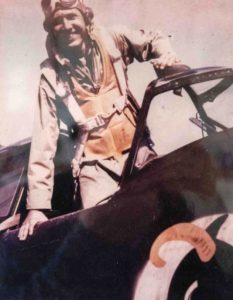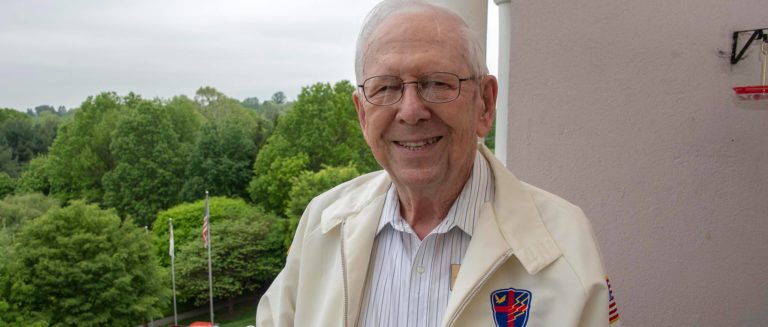
On two wings and a multitude of prayers, Bernie Sledzik flew over the largest amphibious invasion in history.
The resident of Mercy Ridge in Timonium is among the younger survivors of D-Day, the Allied invasion June 6, 1944, which sent 160,000 troops onto the beaches of Normandy, France, during World War II.
Sledzik was above it all, literally, flying four missions over two days in a P-47 in the 406th Fighter Group.
“They had a reported 13,000 planes in the air, and thousands and thousands of ships in the English Channel, boats of all kinds,” Sledzik recalls. “If I did run into engine trouble, chances were 50-50 I could (bail out and) land on a ship, or certainly close to one.”
He has a treasure trove of commendations, documents, photos and knowledge, preserved in a memoir that includes descriptions of his service from the likes of Gen. George S. Patton and United Press radio correspondent Walter Cronkite.
Sledzik, 95, speaks in a tone that belies the hell he encountered. D-Day occurred less than five weeks after he turned 20, and four weeks to the day after the first of his 67 combat missions.

He had, however, the proverbial “Right Stuff,” aplomb, aptitude and character that were vouched for by the principal of Indiana High School in Western Pennsylvania, and the pastor of St. Gertrude Church, who ministered to his Polish immigrant parents.
Sledzik was a high school senior in December 1941, when the Japanese bombed Pearl Harbor and the U.S. entered the war. Like hometown hero Jimmy Stewart, already an Oscar-winning actor, he had trouble meeting the military’s weight requirements, but was accepted into the Army Air Corps in the summer of 1942.
After training for a year in Texas and Florida, the Queen Mary served as his troop transport across the Atlantic in January 1944. In April, his fighter group joined the 514th Fighter Squadron in Ashford, England. While his sister, Dorothy, prayed a series of novenas back home, Sledzik carried his rosary and prayed the Our Father.
He was awakened at 2:30 a.m. D-Day, and took off two hours later in “rain, cold and dark.”

“Our whole group, three squadrons of 12 planes each,” Sledzik said, “we were the first fighter group. Our assignment was to prevent enemy aircraft from coming in to bomb and strafe the invasion.”
They were in the air for two-and-a-half hours, and repeated the mission that night. Sledzik did not come under enemy fire then, but his war just getting started, as the rest of 1944 saw him engage the enemy, carry 1,000-pound bombs and lose comrades.
He protected the Third Army’s right flank on its drive to Paris, leading to the surrender of 20,000 German soldiers and the following from Patton: “The superior efficiency and cooperation afforded this Army by the Air Force is the best example of the combined use of air and ground troops I have ever witnessed.”
That brought the first of his two Presidential Citations. The second came during the Battle of the Bulge, where Sledzik shot down a Messerchmitt Bf109 over Bastogne.
His expertise found him work in the aircraft industry, and in turn, a wife, as he met Brink at Carswell Air Force Base in Texas, where she was a flight nurse. They married in 1953 in Wiesbaden, Germany, where she was stationed. She came home pregnant with the first of their three sons.
He moved to the finance business, which brought the Sledziks to Baltimore in 1975. They worshipped at Church of the Nativity in Timonium before moving to Mercy Ridge, where their view includes a large American flag, which Brink salutes every morning.
“This is my country,” she said. “I love my country.”
Sledzik has been back to Normandy, but won’t be heading to France for the 75th anniversary observance of D-Day.
“I have been given so many handshakes and hugs,” he said.


